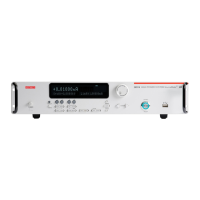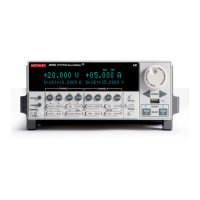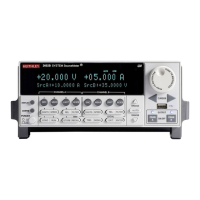Model 2657A High Power System SourceMeter® Instrument Reference Manual Appendix E: Status model
2657A-901-01 Rev. B/December 2012 E-19
Enable and transition registers
In general, there are three types of user-writable registers that are used to configure which bits feed
the register summary bit and when it occurs. The registers are identified in each applicable command
(as listed in TSP commands
(on page 7-8)) as follows:
• Enable register (identified as .enable in each attribute's command listing): Allows various
associated events to be included in the summary bit for the register.
• Negative-transition register (identified as .ntr in each attributes command listing): A particular
bit in the event register will be set when the corresponding bit in the NTR is set, and the
corresponding bit in the condition register transitions from 1 to 0.
• Positive-transition register (identified as .ptr in each attributes command listing): A particular
bit in the event register will be set when the corresponding bit in the PTR is set, and the
corresponding bit in the condition register transitions from 0 to 1.
Controlling node and SRQ enable registers
Attributes to control system node and service request (SRQ) enable bits and read associated
registers are summarized in the Status byte and service request enable registers
(on page E-6). For
example, either of the following will set the system node QSB enable bit:
status.node_enable = status.QSB
status.node_enable = 8
Status register sets
There are five status register sets in the status structure of a High Power System SourceMeter
®
instrument:
• System Summary
• Standard Event Status
• Operation Status
• Measurement Event
• Questionable Status
System Summary Registers
As shown in Status model diagrams (on page E-5), there are five register sets associated with system
status events. These registers summarize system status for various nodes connected to the
TSP-Link
®
network (see TSP-Link system expansion interface (on page 6-49)). Note that all nodes on
the TSP-Link network share a copy of the system summary registers once the TSP-Link system has
been initialized. This feature allows all nodes to access the status models of other nodes, including
service request (SRQ).
In a TSP-Link system, the status model can be configured such that a status event in any node in the
system can set the RQS (request for service) bit of the Master Node Status Byte. See TSP-Link
system status (on page E-26) for details on using the status model in a TSP-Link system.
Commands for the system summary registers are summarized in the Status function summary
(on
page E-4) table.

